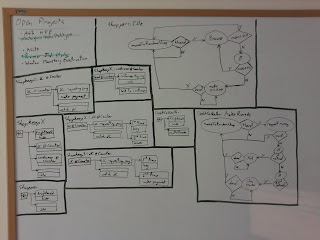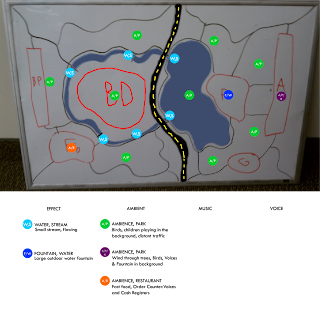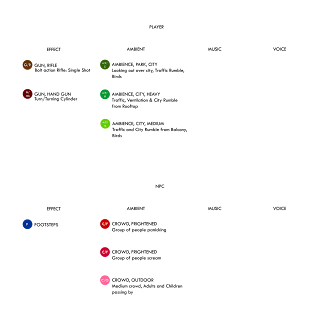 |
| Scout HUD |
About
Remote Shepherd is the capstone project for Long Shot Games, a group of five graduate students in RIT's Game Design and Development masters program. The game allows the player to step into the shoes of a group of vigilantes who have decided to put their skills gained as Marine Scout Snipers to use in cleaning their city of criminal organizations. This blog will track both the ongoing design and development of the project.
Pages
Tuesday, March 29, 2011
Scout Mode
As I mentioned in an earlier post we created a new game mode called Scout where the player views through a camera and has a directional microphone. The first thing to notice the HUD is designed to match what the player would see while looking through the viewfinder on high end digital camera. The squares and circle have no bearing in our game, but are there to simply match what would be seen through a real camera's viewfinder.
Making Comic Book UIs
One of my jobs on this project is as UI design which has been challenging because of the comic book look of the game. All of the Menus and HUDs have to look like something a reader might find in a comic book. As such I have to find some reference material on panel layout, lettering and art styles. If anyone is interested in any of these topics here are a few places to look at.
- A must read for comics would be Understanding Comics by Scott McCloud.
- A great reference for lettering traditions is Comic Book Grammar and Tradition.
- A very helpful adobe illustrator tutorial for comic book lettering by Jim Campbell, https://files.me.com/jim.campbell/qqt5ck.
Sniper Map
One of the new features that came out of the redesign of the missions is that there are now more sniper nests than snipers. This means that the player will be able to reposition the snipers around the mission area. So we had to come up with a system to allow the player to control the position of the snipers and luckily one of the games we looked at during the research phase of the game had such a system. It had stuck with me as it seemed to be a simple solution that added a new menu page and keep the controls simple.
 |
| The Strangers |
Saturday, March 26, 2011
Game Modes / HUDs
This past week we established two play modes for our game, Shooter and Scout. The Shooter mode is the original mechanic of the game where the player uses a rifle and a scope to locate their target and kill them for lethal conclusions. Below is the first version of the HUD for this game mode. In the center is what the sniper sees looking through the scope of their rifle. Around the scope the player can see their current setting for the scope's magnification, elevation adjustment, windage adjustment and a compass to show where they are facing. Then in each corner of the screen there is a designated area for each of the snipers (Alpha, Foxtrot and Whiskey) and the police detective (Delta) to talk.
The new game mode is Scout where the player uses a directional mic attached to a high power camera. The player will use the mic as another method of locating their target and the camera to gather evidence for non-lethal conclusions. In this mode dialogue picked up by the mic is displayed in radio bubbles around in the blacked area of the HUD. Due to how the dialogue is displayed, we removed everything but the compass form the Shooter mode HUD.
 |
| Shooter Mode |
The new game mode is Scout where the player uses a directional mic attached to a high power camera. The player will use the mic as another method of locating their target and the camera to gather evidence for non-lethal conclusions. In this mode dialogue picked up by the mic is displayed in radio bubbles around in the blacked area of the HUD. Due to how the dialogue is displayed, we removed everything but the compass form the Shooter mode HUD.
 |
| Scout Mode |
Repurpose Not Rebuild
As a follow up to my earlier post about scraping our designed levels and building a new one it is important to mention that for the mission redesign we first designed the mission situation and then placed that situation into an environment. This let us build a gameplay experience that would be fun and engaging for our player, which was why we scrapped the first missions in the first place. It also allowed us to make the environment be something that we could use as much of the art assets we had gotten for our art team as we could. As well as keeping old art assets and making the game more fun it was equally important that we redesign the narrative. Mainly because at the time we were unsure how many artists we still had on our art team and Dan and myself would not be able to make enough of the assets we needed. It was also important because all the art we had worked well and there was no need to scrap any of it.
Building a Terrain
One new problem with the redesign of the game's narrative path is that the park is not a flat plane like the market was. This meant we would have to generate a terrain in Maya, which is something difficult for myself to do as the level designer. After a week's worth of searching for plug-ins or external software that would let me design the terrain of the park I decided on the program that would best allow me to generate a terrain and export it into Maya: Nem's Mega 3D Terrain Generator.
After experimenting with all the other solutions I had found, I settled on Nem's Mega 3D Terrain Generator for several reasons. The most important was that it allowed the level designer to quickly generate a terrain using some built-in generation techniques and hand-sculpting tools. This program also allows us to export our terrain as an .OBJ files that we can then import into our Maya scenes, a feature I felt was important to have. The designer also has control of the size and number of triangles of the terrain, which is important for us to make sure we keep our poly count down. Lastly with Nem's Terrain Generator the designer can hand paint each face with a texture which is nicer than Maya's process for applying a face with a particular texture.
After experimenting with all the other solutions I had found, I settled on Nem's Mega 3D Terrain Generator for several reasons. The most important was that it allowed the level designer to quickly generate a terrain using some built-in generation techniques and hand-sculpting tools. This program also allows us to export our terrain as an .OBJ files that we can then import into our Maya scenes, a feature I felt was important to have. The designer also has control of the size and number of triangles of the terrain, which is important for us to make sure we keep our poly count down. Lastly with Nem's Terrain Generator the designer can hand paint each face with a texture which is nicer than Maya's process for applying a face with a particular texture.
 |
| Nem's Mega 3D Terrain Generator |
Friday, March 25, 2011
The World is Not A Round, Spherical Place
AI characters need a way to get around the world, and we considered three ways to let them do this. The first was local avoidance, but this can very easily devolve into dithering unless the level is specifically designed to prevent it. As such we decided to do actual path finding, the only decision left being whether to use a node graph or a navigation mesh. We decided to go with a navigation mesh based on the recommendations of this article. I'll summarize the relevant points here.
Sunday, March 20, 2011
Not The Man I Used To Be
As you know, Remote Shepherd has had a reboot of sorts. What this means for AI is essentially starting over on character design. Previously we had five types of AI planned for the first level (the Market Mission): three different kinds of shopkeepers who would resist the debt collector to varying degrees, regular people just out shopping, and the debt collector himself. While all the designs for the AI characters were finished I had fortunately only implemented the shopper in code.
 Behavior trees and finite state engines for the original AI characters
Behavior trees and finite state engines for the original AI characters
 Behavior trees and finite state engines for the original AI characters
Behavior trees and finite state engines for the original AI charactersIn addition to the problems Eric mentioned in his post, the original design of the second and third missions was incredibly vague in terms of AI and behaviors, and trying to come up with AI to fit the environment and narrative wasn't working ("So what'll be the NPCs be doing in Mission 2?" "Uhhh"). With the new park environment we have a much larger pool of behaviors that people might engage in in that space, and the hard part became trimming the list to behaviors that served our gameplay purpose: to act as a red herring. This trimming is just a prioritization though, not a deletion of any behaviors. The game will also need AI characters that are not red herrings, but are there to flesh out the environment and make it seem realistic and alive. The three characters (in addition to the unique target characters) that we have prioritized are: The Reader, The Walker, and The Jogger.
Saturday, March 19, 2011
The Soundscape (First Design)
The Soundscape for this game will be similar to the Central Park in NYC or the Middle Park in GTA IV.


The types of sound that can be heard in public parks are as following :-
- Birds
- Sounds of Nature
- People/Crowd
- Vehicle/Traffic
- Music
- Air Traffic
- Machines
Below is the first design for the Soundscape of the game's level.


Friday, March 18, 2011
Paramount Park Concept
The new mission for Remote Shepherd takes place in a large park in the center of the downtown borough of River Ridge. The design of the park is heavily influenced by both Central Park in NYC and Middle Park in GTA IV. For our level the Central Park was too large for us to recreate with our time limit and the layout of Middle Park did not match well with what we needed out of the space for our game.
Mole Hunt - Mission Briefing
We (Remote Shepherd vigilante group) have been working to remove the hold organized crime has on River Ridge City for the better part of two years. We have managed to remove most of the low level gangs, but this has led to the remaining organizations working together to take us out, operating under the moniker "Wilcox-Arlington Management Group." (WAMG) One of the member crime families, we don't know which, has managed to gain one, if not more, informants inside of the RRPD. These informants are both giving police information to the crime families and manipulating the actions of the police department.
I (Delta) have been able to obtain information that a transfer between one of the informants and an intelligence officer for WAMG is going down in Paramount Park today. I was unable to obtain any information on the informant, but was able get the files on the intelligence officer. You will have to use the intelligence officer in order to uncover the informant. The intelligence officer will be attempting to maintain a low profile but he will be accompanied by his personal bodyguard.
Once you’ve located the intelligence officer, do not lose him. He will surely be cautious and aware that we are hunting him. You’ll also have to pay close attention to anyone near the intelligence officer as I am sure he and the informant will attempt to disguise their meeting as something else. I cannot stress enough that the goal of this mission is to stop the flow of information and the manipulation of the police department. I don’t care how you achieve this goal; just make sure you don’t screw this up.
I (Delta) have been able to obtain information that a transfer between one of the informants and an intelligence officer for WAMG is going down in Paramount Park today. I was unable to obtain any information on the informant, but was able get the files on the intelligence officer. You will have to use the intelligence officer in order to uncover the informant. The intelligence officer will be attempting to maintain a low profile but he will be accompanied by his personal bodyguard.
Once you’ve located the intelligence officer, do not lose him. He will surely be cautious and aware that we are hunting him. You’ll also have to pay close attention to anyone near the intelligence officer as I am sure he and the informant will attempt to disguise their meeting as something else. I cannot stress enough that the goal of this mission is to stop the flow of information and the manipulation of the police department. I don’t care how you achieve this goal; just make sure you don’t screw this up.
Friday, March 11, 2011
Once Upon A Time
There is a fair amount of information on the web about stories in video games. I know when I started looking for articles it was hard to find any worth reading, so I figured I'd give anyone out there a head start.
Game Design as Narrative Architecture
Is a great article on narrative in games and environmental storytelling.
paranoidproductions.com
I would recommend anything from Richard Rouse III. “Seven Ways a Video Game Can Be Moral” and “Environmental Narrative: Your World is Your Story” are both great places to start.
What Happened Here?
Is a great presentation on environmental storytelling.
onethree.org/talks
“Player-Driven Stories: How Do We Get There?” is a great talk on ways to allow the player to branch the story and ways to let this happen that don’t kill the people making the content.
“No Explanation Necessary: Minimizing Exposition in Game” is a great talk if you can find it somewhere on the web or in the GDC vault.
Game Design as Narrative Architecture
Is a great article on narrative in games and environmental storytelling.
paranoidproductions.com
I would recommend anything from Richard Rouse III. “Seven Ways a Video Game Can Be Moral” and “Environmental Narrative: Your World is Your Story” are both great places to start.
What Happened Here?
Is a great presentation on environmental storytelling.
onethree.org/talks
“Player-Driven Stories: How Do We Get There?” is a great talk on ways to allow the player to branch the story and ways to let this happen that don’t kill the people making the content.
“No Explanation Necessary: Minimizing Exposition in Game” is a great talk if you can find it somewhere on the web or in the GDC vault.
Hit The Redo Button
Last week a few of us attended GDC and I managed to attend several of the sessions dealing with different aspects of a games narrative. Along with giving me tons of new information I could apply towards our game it also gave me the chance to take a step back and examine "Remote Shepherd". By the time I got back from GDC I had determined that I had made a major design mistake as far as our missions went.
I had designed the missions first around a narrative ark and then tried to wrap gameplay around it. This left us with a story that we were unsure we could tell with a shrinking art team and a game that I did not see as fun anymore. So I had determined that we needed to scrap the missions we had designed for the story and craft a new one that was designed around the gameplay.
I had designed the missions first around a narrative ark and then tried to wrap gameplay around it. This left us with a story that we were unsure we could tell with a shrinking art team and a game that I did not see as fun anymore. So I had determined that we needed to scrap the missions we had designed for the story and craft a new one that was designed around the gameplay.
Subscribe to:
Comments (Atom)
